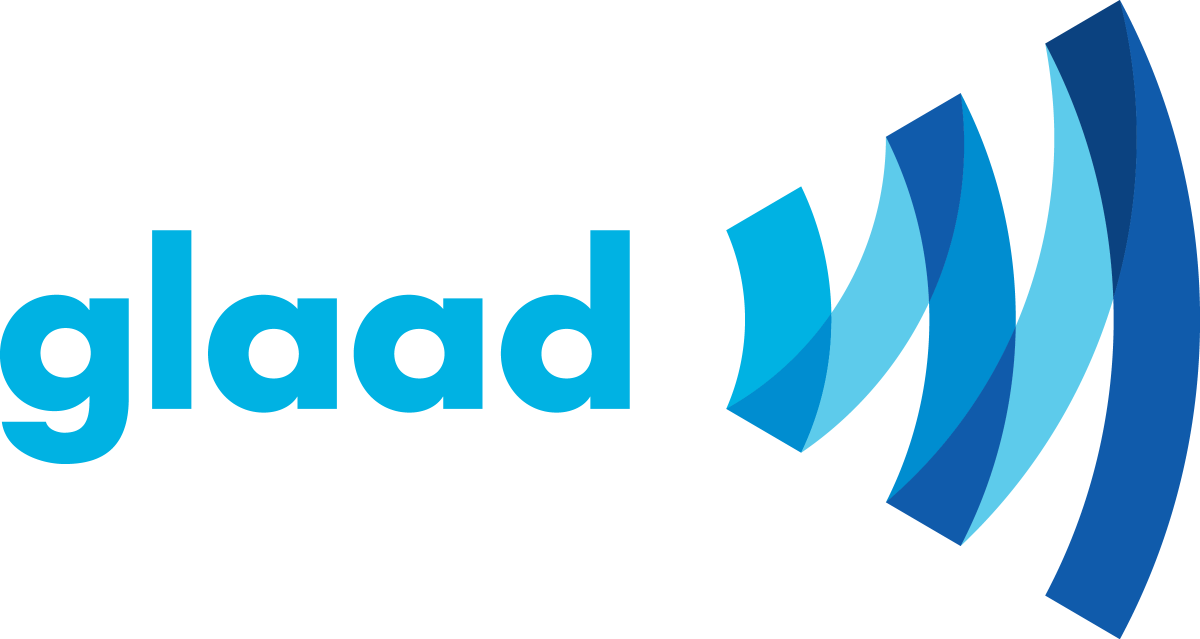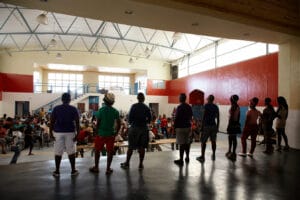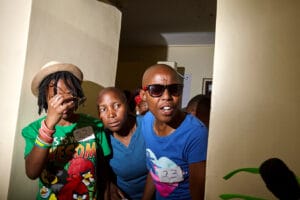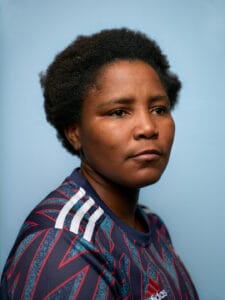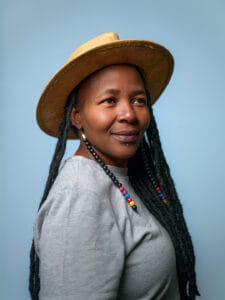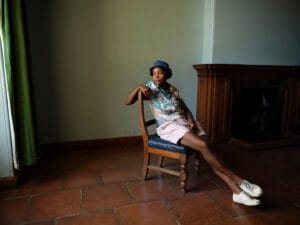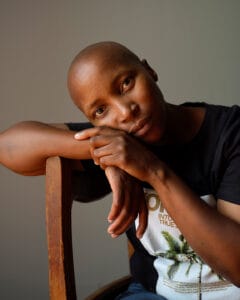This report brings an academic and personal voice of the impact that the COVID-19 pandemic has had to-date on the fight to end the HIV epidemic, while also providing recommendations/ needs from people at community based organizations (CBOs) who serve and support the community. We underscore the disruption in access to HIV prevention and care services due to mitigation measures imposed in the early days of the COVID-19 pandemic, which will have implications for many years to come. We also highlight innovation to HIV service delivery that provided an important bridge between healthcare professionals and clients in an unprecedented time. Our recommendations will help sustain the fight against HIV in the United States in the midst of this pandemic, and future health emergencies.
Join GLAAD and take action for acceptance.
- We All Could Use Some Queer Joy! Be a Part of The Skin Deep + GLAAD’s New Collab
- GLAAD’s Black Queer Creative Summit Returns to Los Angeles for a Powerful Second Year
- The GLAAD Wrap: ‘Kiss of the Spider Woman’ ‘After the Hunt’ and ‘Fairyland’ in theaters, trailers for ‘I Love LA’ ‘All’s Fair,’ and more!
- RECAP: Supreme Court to Rule on Protections Against Discredited and Unsafe Conversion “Therapy” Practices on LGBTQ Youth
- Facts and Action for Banned Books Week
- Write It Out! Launches Annual Campaign to Uplift People Living with HIV Through Playwriting
- GLAAD Gaming Announces New Queer Emerging Developers Program
- Finding Yourself Begins With Celebrating Others’ Differences
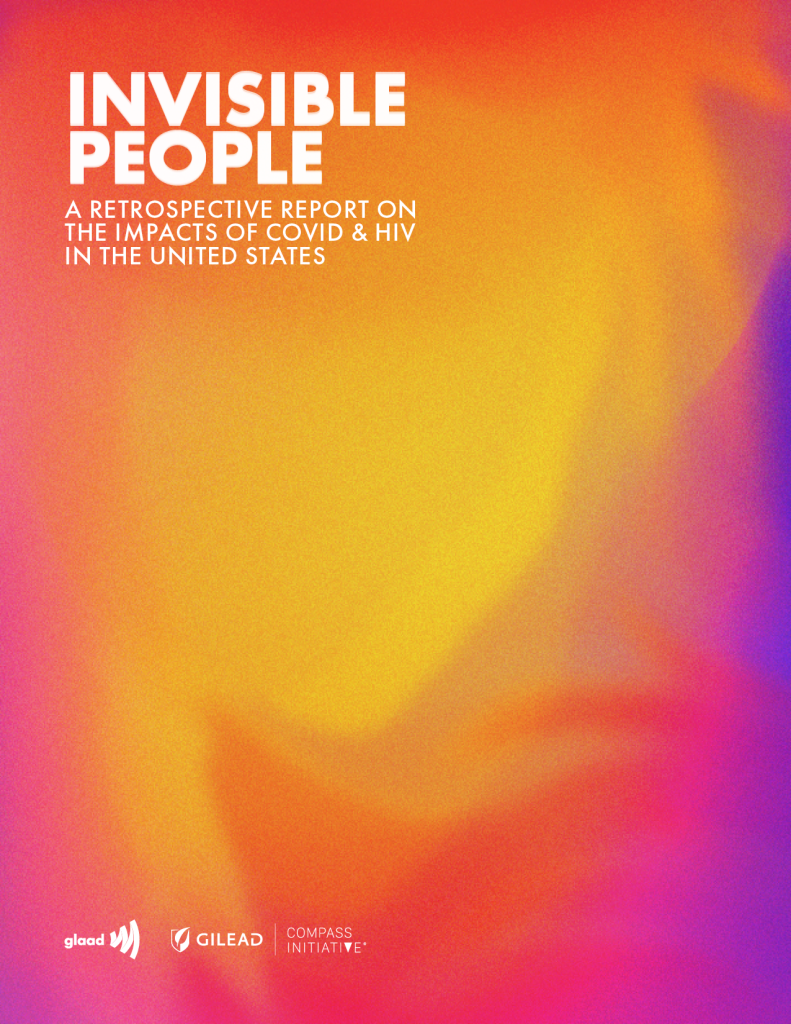
Invisible People: A Retrospective Report on the Impacts of COVID & HIV in the United States
Introduction from Sarah Kate Ellis
GLAAD’s mission to ensure accurate and inclusive LGBTQ representation across media has never been more urgent, especially in the story that has dominated all of our lives these last two and a half years, the COVID-19 pandemic. LGBTQ people and queer people of color are disproportionately affected in the pandemic, yet data collection didn’t begin for months to help guide responses and resources, and our voices were vastly underreported across the media. These are painful parallels to the early days of HIV/AIDS, when GLAAD was formed to fight inaccuracy and invisibility. Combined with systemic intolerance and indifference, it led to incalculable loss. Read More
Statement from Adedotun A. Ogunba Jo, PHD, MPH, MHS
“The COVID pandemic is personal, very personal. On March 11, 2020, the World Health Organization declared the novel coronavirus a global pandemic. Three weeks later, I successfully defended my doctoral dissertation in public health. Exactly a week after that, a phone call from my father at an odd time signaled trouble. He was calling to let me know my mother’s COVID symptoms had significantly worsened, and the ambulance was on its way to our house. I listened helplessly as my mother gasped for air that her lungs couldn’t find. The three weeks that followed consisted of anguish, anxiety, and angst as her life hung in a balance, aided by a ventilator and the prayers of friends and family, both near and far.” Read More
Addendum about Monkeypox (MPX)
This report was conceptualized and developed prior to the onset of the recent monkeypox (MPX) outbreak in the U.S. Currently, an overwhelming majority of MPX cases in the U.S. is among Black and Latino sexual minority men [1], mirroring the HIV epidemic. Additionally, preliminary data suggests that MPX disproportionately affects people living with HIV [2]. While vaccinations for MPX are beginning to be rolled out nationwide, there is still a shortage of vaccines and vaccine eligibility criteria differ by state and localities. Read More
Key Findings
This report brings an academic and personal voice of the impact that the COVID-19 pandemic has had to-date on the fight to end the HIV epidemic, while also providing recommendations/needs from people at community- based organizations (CBOs) who serve and support the community. We underscore the disruption in access to HIV prevention and care services due to mitigation measures imposed in the early days of the COVID-19 pandemic, which will have implications for many years to come. Read More
Invisible No More: In Their Own Words Part 1
“So, that’s my take from my experience living with HIV during the COVID pandemic…, I became an invisible person by the medical community.”
-Person Living With HIV (PLWH), 32 years old, Western US Read More
Acknowledgements of Languages and Communities
Identifying the race or ethnicity of a person or group of participants, along with other sociodemographic variables, may provide information about participants included in a study and the potential generalizability of the results of a study and may identify important disparities and inequities. The term “Black” refers to people of the African diaspora, no matter their nationality. While sometimes “African American” refers to people who were born in the United States and have African ancestry. Read More
The Disproportionate Impact of the COVID-19 Pandemic
More than two years into the coronavirus (COVID-19) pandemic, the United States (U.S.) has recorded over 83.6 million cases, 4.7 million hospital admissions, and over 1 million lives lost (CDC, 2022). Various studies have shown a significantly higher rate of COVID-19 hospitalization and death among racial minorities in the U.S. [1-3]. According to the Centers for Disease Control and Prevention (CDC), racial minority communities (Black, Hispanic, and American Indian/Alaska Natives) in the U.S. are 2-3 times more likely to be hospitalized and die due to COVID-19 complications compared to White Americans. Read More
The Pre-Pandemic State of HIV in the United States
In 2019, before the start of the COVID-19 pandemic, there were 1.2 million people living with HIV (PLWH) in the U.S. with 36,801 new diagnoses that year. Sexual minority men (SMM) including gay, bisexual and other men who have sex with men are disproportionately affected by HIV, making up 69% of all new HIV diagnoses in 2019 [CDC]. Black SMM have a 1 in 2 lifetime risk of HIV diagnosis compared to 1 in 5among Hispanic/Latino SMM and 1 in 11 among White SMM [11]. Additionally, a vast majority of the states with the highest lifetime risk of getting HIV were in the southern region of the U.S. [11]. Read More
The Intersection of COVID-19 & HIV
The intersection between the HIV epidemic and COVID-19 pandemic, especially as it relates to communities that are most vulnerable to transmission and death, cannot be overstated. The HIV epidemic in the U.S. has disproportionately affected marginalized communities including racial/ethnic minorities, young people, sexual minorities (specifically gay and bisexual cisgender men and transgender women), and people who inject drugs. The same societal-level systems of oppression and marginalization that increase vulnerability to HIV such as racism, stigma, economic disenfranchisement, and neighborhood disadvantage have been implicated in the disproportionate impact of the COVID-19 pandemic. Read More
The Effects of COVID-19 on HIV Testing

Testing is the first step in HIV prevention [19], as knowledge of one’s status facilitates engagement in HIV prevention services for those who are negative and linkage to treatment services for people living with HIV. It also prevents the spread of HIV among people who are unaware of their status. Various studies have reported significant decreases in HIV testing rates across the U.S. [20-22] as a result of the pandemic. Specifically, a study conducted in four geographically diverse regions found between a 68-97% reduction in HIV testing rates during the stay-at-home order period compared to early 2020 (prestay-at-home order period) [20]. Read More
The Effects of COVID-19 on Prevention

The best approach to HIV prevention is a combination of condom distribution, health education, syringe exchange services, and initiation of and continued adherence to pre-exposure prophylaxis (PrEP; HIV prevention medication). Prior to the pandemic, these services were delivered primarily in person through clinics, hospitals, community centers, and outreach events in social spaces frequented by the target population (clubs, bars, bookstores, etc). Stay-at- home orders and widespread closings of social spaces due to the COVID-19 pandemic significantly affected access to HIV prevention services, and face- to-face client interactions were suddenly halted and transitioned to virtual spaces. Read More
The Effects of COVID-19 on Care
Engagement in comprehensive HIV care services including adherence to antiretroviral medications ,doctor visits, psychosocial services, and support groups is necessary to living and thriving with HIV. The COVID-19 pandemic has upended the ability for PLWH to adequately engage with these vital services. There is evidence about PLWH being more vulnerable to getting COVID-19. A systematic review examining the epidemiology of COVID-19 rates and mortality among PLWH found that PLWH had significantly higher risk of getting COVID-19 and mortality from COVID-19 compared to HIV-negative individuals [29]. Read More
Invisible No More: In Their Own Words Part 2
“It’s been very difficult to find a doctor and health care team that’s supportive of my transition. I went through a lot of bad doctors before I started seeing one who was open to me and open to listening to me. I had to move back in with my parents. I’ve been purchasing HRT online since then, but it’s very expensive. I really want to go back to my medical team.”
-Trans Fem & NonBinary, Androphilic, Latinx, 25 years old, Southern US
Read More
Impact on Community Based Organizations
The role of HIV CBOs during the COVID-19 pandemic is of the utmost importance. Almost overnight, CBOs were forced to adapt the delivery of HIV-related services as a result of an unprecedented global event. Additionally, many organizations broadened their service offerings to include COVID-19 testing, distribution of food and other personal care items, and psychosocial health services, while dealing with staff shortage and budgetary restrictions [36]. The pandemic severely impacted how CBOs interface with their existing and new clients, with a pivot from in-person to more virtual channels of interactions [37]. Read More
A Few Observed Parallels in Stigma
GLAAD conducts annual research around HIV stigma, to better understand how much stigma still exists, the challenges we must overcome to end HIV-related stigma, and what the impact is on those living with HIV. In our research we have found that less than half (48%) of Americans feel knowledgeable about HIV, and there is still unfounded fear about people living with HIV, even though those receiving proper medical treatment cannot transmit HIV. For more information on our HIV Stigma work please reference GLAAD’s State of HIV Stigma Study. Read More
COVID-19 Vaccine Development

Through our interviews we heard that the development and approval of the COVID-19 felt “too quick”. This caused hesitancy, distrust, and delay, particularly early on among Black clients, who recalled prior studies with a racist history. Other reasons given in our qualitative interviews for initial mistrust and delayed vaccine adoption included misinformation from leadership, unclear messaging, and lack of diversity in messaging. Read More
Recommendations
- More funding, and unrestricted funding is needed.
- Leverage lessons learned during the pandemic to innovate and advocate.
- Adopt a differentiated and person-centered service approach.
- Comprehensive public health messages could include COVID-19 vaccination and PREP for prevention.
- Clear and simple messaging for future vaccine rollouts.
Methodology / Statement from IPSOS
For this report we conducted a comprehensive analysis of peer-reviewed scientific literature, combined with qualitative interviews of people living with HIV (PLWH), affected communities, and community-based organizations (CBOs) that serve these populations. We conducted 26 individual interviews (20 clients, 6CBO staff) moderated by Ipsos, a leading market research company. The interviews with clients explored how the COVID-19 pandemic affected their access to HIV- related services, psychosocial services, and other support systems. Read More
Acknowledgements
The GLAAD Media Institute provides training, consultation, and actionable research to develop an army of social justice ambassadors for all marginalized communities to champion acceptance and amplify media impact. Journalists and media interested in speaking to a GLAAD spokesperson, please inquire at press@glaad.org. Those interested in learning more about the GLAAD Media Institute and its services including consultation, research and contextualized education, media and cultural competency training and more, please visit us here. Read More
The Table of Contents
- Introduction from Sarah Kate Ellis
- A Statement from Adedotun Ogunbajo, PHD, MPS, MHS
- Addendum about Monkeypox (MPX)
- Key Findings
- Invisible No More: In Their Own Words Part 1
- Acknowledgements of Languages and Communities
- The Disproportionate Impact of the COVID-19 Pandemic
- The Pre-Pandemic State of HIV in the United States
- The Intersection of COVID-19 & HIV
- The Effects of COVID-19 on Testing
- The Effects of COVID-19 on HIV Prevention
- The Effects of COVID-19 on Care
- Invisible No More: In Their Own Words Part 2
- Impact on Community Based Organizations
- A Few Observed Parallels in Stigma
- COVID-19 Vaccine Development
- Recommendations
- Methodology / Statement from IPSOS
- Acknowledgements
- References
To view the 2023 State of HIV Stigma Study click here.
To view the 2022 State of HIV Stigma Study click here.
To view the 2021 State of HIV Stigma Study click here.
To view the 2020 State of HIV Stigma Study click here.
Kirby, T., Evidence mounts on the disproportionate effect of COVID-19 on ethnic minorities. The Lancet Respiratory Medicine, 2020. 8(6): p. 547-548.
Millett, G.A., et al., Assessing differential impacts of COVID-19 on Black communities. Annals of Epidemiology, 2020.
Kullar, R., et al., Racial disparity of coronavirus disease 2019 in African American Communities. The Journal of infectious diseases, 2020. 222(6): p. 890-893.
Killerby, M.E., et al., Characteristics associated with hospitalization among patients with COVID-19—Metropolitan Atlanta, Georgia, March–April 2020. Morbidity and Mortality Weekly Report, 2020. 69(25): p. 790.
Garg, S., et al., Hospitalization rates and characteristics of patients hospitalized with laboratory-confirmed coronavirus disease 2019—COVID-NET, 14 States, March 1–30, 2020. Morbidity and mortality weekly report, 2020. 69(15): p. 458.
Price-Haywood, E.G., et al., Hospitalization and mortality among black patients and white patients with Covid-19. New England Journal of Medicine, 2020. 382(26): p. 2534- 2543.
Williamson, E.J., et al., Factors associated with COVID-19-related death using OpenSAFELY. Nature, 2020. 584(7821): p. 430-436.
Jordan, R.E., P. Adab, and K. Cheng, Covid-19: risk factors for severe disease and death. 2020, British Medical Journal Publishing Group.
Mody, A., et al., Understanding Drivers of COVID-19 Racial Disparities: A Population-Level Analysis of COVID-19 Testing among Black and White Populations. Clinical Infectious Diseases, 2020.
Hooper, M.W., A.M. Nápoles, and E.J. Pérez-Stable, COVID-19 and racial/ ethnic disparities. Jama, 2020. 323(24): p. 2466-2467.
Hess, K.L., et al., Lifetime risk of a diagnosis of HIV infection in the United States. Annals of epidemiology, 2017. 27(4): p. 238-243.
Fauci, A.S. and G.K. Folkers, Toward an AIDS-free generation. Jama, 2012. 308(4): p. 343-344.
Khazanchi, R., C.T. Evans, and J.R. Marcelin, Racism, not race, drives inequality across the COVID-19 continuum. JAMA network open, 2020. 3(9): p. E2019933-e2019933.
Muñoz-Price, L.S., et al., Racial disparities in incidence and outcomes among patients with COVID-19. JAMA network open, 2020. 3(9): p. E2021892-e2021892.
Quan, D., et al., Impact of race and socioeconomic status on outcomes in patients hospitalized with COVID-19. Journal of general internal medicine, 2021. 36(5): p. 1302-1309.
Garnier, R., et al., Socioeconomic disparities in social distancing during the COVID-19 pandemic in the United States: observational study. Journal of medical Internet research, 2021. 23(1): p. E24591.
Sehgal, A.R., D.U. Himmelstein, and S. Woolhandler, Feasibility of separate rooms for home isolation and quarantine for COVID-19 in the United States. Annals of internal medicine, 2021. 174(1): p. 127-129.
Selden, T.M. and T.A. Berdahl, COVID-19 and racial/ethnic disparities in health risk, employment, and household composition: study examines potential explanations for racial-ethnic disparities in COVID-19 hospitalizations and mortality. Health Affairs, 2020. 39(9): p. 1624-1632.
McNairy, M.L. and W.M. El-Sadr, A paradigm shift: focus on the HIV prevention continuum. Clinical Infectious Diseases, 2014. 59(suppl_1): p. S12-S15.
Moitra, E., et al., Impact of the COVID-19 pandemic on HIV testing rates across four geographically diverse urban centres in the United States: An observational study. The Lancet Regional Health-Americas, 2022. 7: p. 100159.
Menza, T.W., et al., The impact of the SARS-CoV-2 pandemic on human immunodeficiency virus and bacterial sexually transmitted infection testing and diagnosis in Oregon. Sexually Transmitted Diseases, 2021. 48(5): p. E59-e63.
Bonett, S., et al., The impact of the COVID-19 pandemic on sexually transmitted infection/human Immunodeficiency virus testing among adolescents in a large pediatric primary care network. Sexually Transmitted Diseases, 2021. 48(7): p. E91-e93.
Fistonich, G.M., K.M. Troutman, and A.J. Visconti, A pilot of mail-out HIV and sexually transmitted infection testing in Washington, District of Columbia during the COVID-19 pandemic. American Journal of Preventive Medicine, 2021. 61(5): p. S16-S25.
Menza, T.W., et al., Rapid uptake of home-based HIV self-testing during social distancing for SARS-CoV2 infection in Oregon. AIDS and Behavior, 2021. 25(1): p. 167-170.
Hecht, J., et al., Increasing Access to HIV Testing Through Direct-to-Consumer HIV Self-Test Distribution—United States, March 31, 2020–March 30, 2021. Morbidity and Mortality Weekly Report, 2021. 70(38): p. 1322.
Patel, V.V., et al., HIV Prevention and Treatment in the Context of the COVID-19 in the Bronx, New York: Implications for Practice and Research. AIDS reviews, 2020. 22(3): p. 143.
Hill, B.J., B. Anderson, and L. Lock, COVID-19 pandemic, Pre-Exposure Prophylaxis (PrEP) Care, and HIV/STI testing among patients receiving care in three HIV epidemic priority states. AIDS and Behavior, 2021. 25(5): p. 1361- 1365.
Krakower, D., et al., Impact of COVID-19 on HIV preexposure prophylaxis care at a Boston community health center. Journal of the International Aids Society, 2020: p. 176-177.
Ssentongo, P., et al., Epidemiology and outcomes of COVID-19 in HIV-infected individuals: a systematic review and metaanalysis. Scientific reports, 2021. 11(1): p. 1-12.
Norwood, J., et al., The Impact of COVID-19 on the HIV Care Continuum in a Large Urban Southern Clinic. AIDS and Behavior, 2022: p. 1-5.
Mgbako, O., et al., COVID-19, telemedicine, and patient empowerment in HIV care and research. AIDS and Behavior, 2020. 24(7): p. 1990-1993.
Auchus, I.C., et al., Transitioning to telehealth during the COVID-19 pandemic: Patient perspectives and attendance at an HIV clinic in San Francisco. AIDS Patient Care and STDs, 2021. 35(7): p. 249-254.
Galaviz, K.I., et al., Patient experiences with telemedicine for HIV care during the first COVID-19 wave in Atlanta, Georgia. AIDS Research and Human Retroviruses, 2022. 38(5): p. 415-420.
Ender, P.T., et al., Rapid implementation of a telemedicine program in a Ryan White–funded HIV clinic during a global pandemic. JAIDS Journal of Acquired Immune Deficiency Syndromes, 2022. 89(1): p. E2-e4.
Yelverton, V., et al Telehealth for HIV Care Services in South Carolina: utilization, barriers, and promotion strategies during the COVID-19 pandemic. AIDS and Behavior, 2021. 25(12): p. 3909-3921.
Kay, E.S. and K. Musgrove, From HIV to coronavirus: AIDS service organizations adaptive responses to COVID-19, Birmingham, Alabama. AIDS and Behavior, 2020. 24(9): p. 2461-2462.
MacNeill, J.J., et al., From crisis to crisis: impacts of the COVID-19 pandemic on people living with HIV and HIV/AIDS service organizations in Indiana. BMC health services research, 2022. 22(1): p. 1-11.
More Publications
Share this
Join GLAAD and take action for acceptance.
ALERT Desk Incident Reporting
Our Picks
Topics
Don't Miss
Write It Out! (WIO!), the groundbreaking writing program centering people living with HIV and AIDS,…
